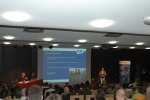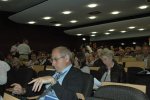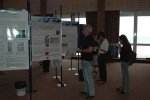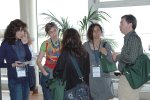
Article
4th Annual Meeting, France 2010
The 4th Annual Meeting EPIZONE, entitled "Bridges to the Future", was held in Saint Malo, France, from 7-10 June 2010. This meeting was hosted by AFSSA (Agence Francaise de Securite Sanitaire des Aliments) France, one of the 17 partner institutes of EPIZONE.
About 340 participants from 27 countries attended; scientists, from many different fields of research, from inside and outside EPIZONE, sponsors and policy makers. Also 11 other (EU) projects presented their work.
243 abstracts were submitted, during the meeting 36 oral presentations were given and around 200 posters were setup. 5 Keynote speakers were invited and special this year was the interactive session on ''Major Epidemic Threats" prepared by EPIZONE's Theme 7, working on Risk Assessment.
Throughout the conference there was plenty of time to review and discuss the posters, to network and to participate in the invited (EU) project presentations of GFRA, FluLabNet, ICONZ, CSFV go DIVA, NEW-Flubird, ArboZoonet, FLUTEST, WildTech, GlaD, FLUTRAIN, and MED-VET-NET.
7 June
Monday 7 June, many work package meetings were held and the EPIZONE Internal Call BT-DYNVECT presented their findings of the one year project in a satellite Symposium: Establishing the transmission dynamics of Bluetongue serotype 8 and entomological aspects in Northern Europe. ( see programme). Young EPIZONE had a full day programme with three workshops: networking, job interviews and CV writing. The Young EPIZONE meeting was held the day before the main EPIZONE meeting and was split into several sessions and workshops.
Emma Fishbourne with a small impression: "Incorporating the theme of 'Building Bridges to the Future' and with positive feedback from the previous annual meeting we decided to focus on networking and communication. In the morning session people were randomly allocated groups and were given a debate topic with information and time in those groups to prepare their cases which were presented to everyone.
The afternoon session comprised a networking presentation on why and how to improve your networking followed by small group work to prepare an 'elevator pitch'. This was followed by presentations from Merial and Qiagen representatives on what they look for in a CV and at the interview." You can read the full report here.
8 June
Dr Rob Raynard, from University of Aberdeen; Scottish Fish Immunology Research Centre, was the first keynote speaker on Tuesday 8 June with the presentation entitled: 'Infectious Salmon Anaemia: emergence, control and surveillance in Aquaculture'. "The disease was first reported from Norway in 1984, where it is still widespread. Subsequently it occurred in Canada, the USA, the Faeroe Islands and Chile. An outbreak occurred in Scotland in 1998/9 and this was eradicated at a cost then over £20M." The keynote lecture was followed by oral presentations from EPIZONE's Theme 4, Diagnostics, (see abstract book for all oral presentations, available as download ).
The afternoon session highlighted EPIZONE's Theme 5, Intervention Strategies, and was opened by keynote speaker Dr Ken Mc Cullough, from Institute of Virology and Immunoprophylaxis (IVI), with the lecture: 'Viruses, Vaccines and Dendritic Cells: a question of Life, the Universe and Everything?' "Dendritic cells (DC) play a critical role in immune defence development by mediating the interaction of various components within the innate and adaptive immune compartments. During the last decade, the increase in our knowledge on the critical role of DC has elaborated our understanding of how viruses evade and modulate immune defence processes, as well as promoted research and development of vaccines for targeting DC."
9 June "Major Epidemic Threats"
The second day of the meeting focused on the special topic of this year "Major Epidemic Threats" and started with the keynote speaker Dr Hana Weingartl, from the Canadian Food Inspection Agency, giving a presentation entitled: 'Susceptibility of pigs to Zaire Ebola virus and their potential as an intermediate host species' .
"Ebola viruses are one of the examples of re-emerging pathogens in humans and nonhuman primates. Swine was not suspected to be a potential host for these viruses, until detection of Reston Ebola virus in pigs in thePhilippines. Subsequently, specific antibodies were found in pig farmers indicating exposure to the virus. This important observation raised the possibility that pigs may be an amplifying species and trans Ebola virus also to humans"
During the previous days, Young EPIZONE organized a poster walk where Young EPIZONE members worked in groups of 2 or 3 and rated all the posters and presented their top 2 or 3 in each category to the rest of the group highlighting why they had been chosen. They elected the prizes for the best PhD and non PhD posters.
In the afternoon session two keynote speakers presented their work: Professor Ian Brown from Veterinary Laboratories Agency with: 'Threats to animal health from influenza, an EU perspective and
Professor Chris Olsen from University of Wisconsin-Madison; School of Veterinary Medicine with: 'Swine influenza in North America: virus evolution, control and public health implications' .
Ian Brown: " During the last ten years there have been multiple threats to animal health in the EU from influenza. Primarily this has involved outbreaks in domestic poultry with highly pathogenic avian influenza (HPAI) of various subtypes. The cost to the industry and the community can be estimated in billions of Euros. Other influenza viruses present significant disease threat to other hosts such as the recent pandemic (H1N1) 2009 virus whereby spread to animal populations provides additional challenges to the veterinary community and industry alike."
Chris Olsen:" Pigs have suffered the effects of influenza virus infection since at least the 1930s. For six decades, the primary cause of influenza in North American pigs was viruses of the classical swine influenza H1N1 lineage. However, in the late 1990s, a wide variety of novel reassortant viruses of multiple subtypes emerged within the North American swine population, with differing implications for both swine and human health"
10 June
A GFRA Workshopwas held on Thursday 10 June, with an introduction of the project and examples of GFRA activities. The workshop ended with roundtable discussions (see programme).












